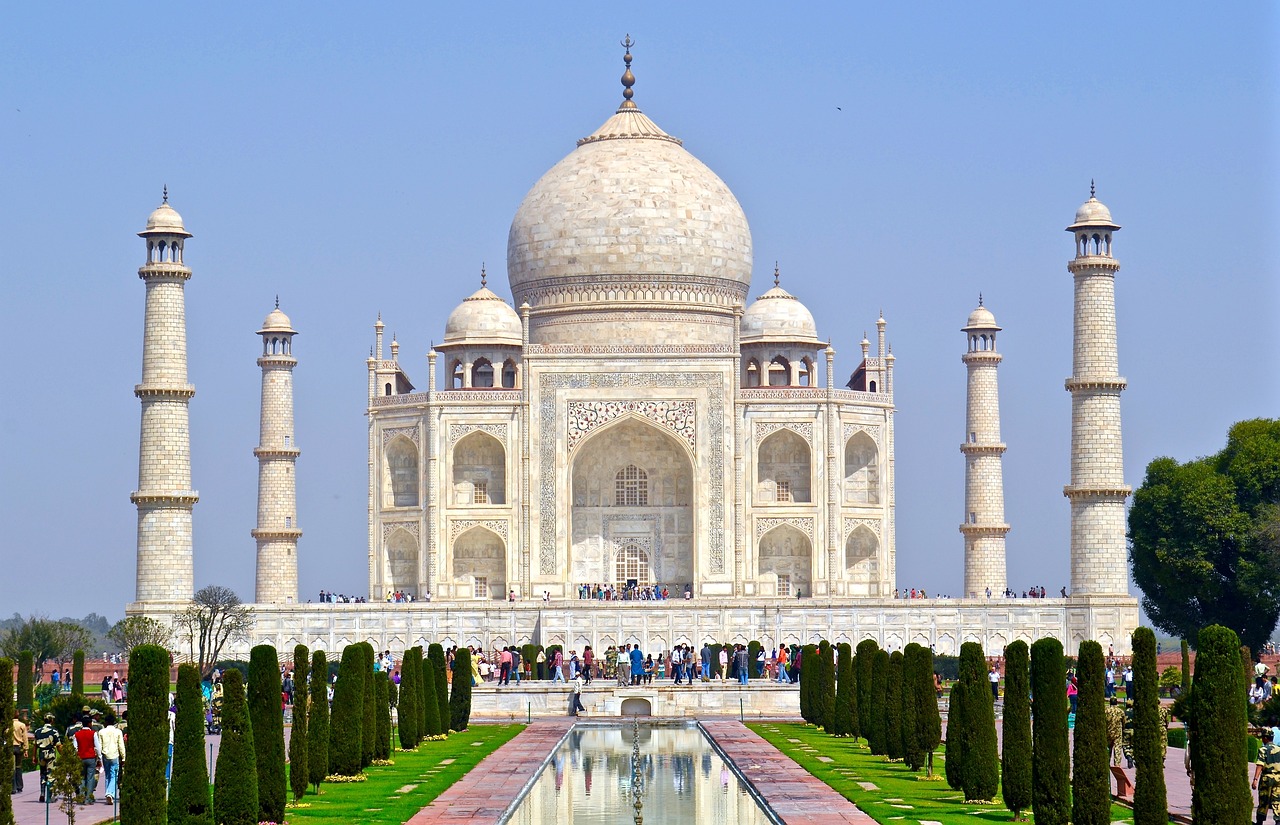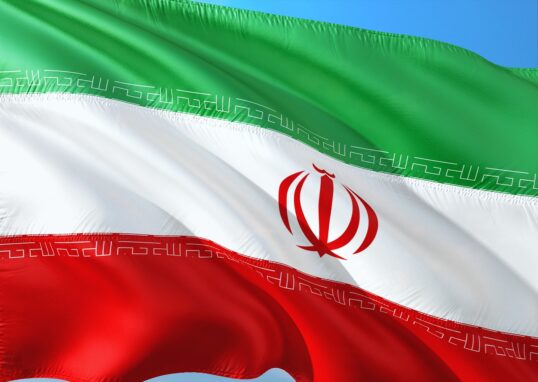
Taj Mahal: Where Marble Weeps a Love Story in Moonlight
The World’s Most Beautiful Sigh, Shah Jahan’s Monument to Lost Love, the Taj Mahal in Agra, India, is an iconic UNESCO World Heritage Site with exemplary Mughal architecture. It was constructed in 1632 by Shah Jahan to serve as a mausoleum for his wife, Mumtaz Mahal, and it stands as a symbol of eternal love. This site is also in the prestigious list “New Seven Wonders of the World” nowadays. The Mumtaz Mahal and Shah Jahan graves are in the central mausoleum, which is flanked by four minarets. The Charbagh (Mughal garden) surrounding it is a serene oasis with symmetrical pathways, fountains, and reflecting pools that enhance the monument’s beauty.
 Agra is also home to several other historical gems that are the ideal complement to a visit to the Taj Mahal. The Agra Fort is a vast red sandstone fort that served as the primary residence of the Mughal emperors. The Taj Mahal is a pilgrimage destination for travelers seeking beauty, history, and culture, built from white marble and intricate carvings, adorned with gemstones, and surrounded by lush gardens.
Agra is also home to several other historical gems that are the ideal complement to a visit to the Taj Mahal. The Agra Fort is a vast red sandstone fort that served as the primary residence of the Mughal emperors. The Taj Mahal is a pilgrimage destination for travelers seeking beauty, history, and culture, built from white marble and intricate carvings, adorned with gemstones, and surrounded by lush gardens.
The Taj Mahal is best at sunrise or sunset, when the marble shines in soft light, like magic. Its mosques, palaces, and courtyards give an idea of the Mughal empire’s greatness and power. Mehtab Bagh, a moonlit view over the Yamuna River, offers a fantastic Vista from the Taj Mahal in the evening.
The Taj Mahal, Agra, India
Architectural Features
Main Mausoleum
The entire structure was constructed with white marble from Makrana, Rajasthan, an architectural idea unique to Shah Jahan. It is situated on a square platform, with a wide dome at its center and four smaller domes surrounding it.
Symmetry and Proportions
The design language is symmetrical and reflects the slightly tilted minarets, which resolve tensional forces caused by earthquakes. The layout and buildings inside the garden are also symmetrical.
Inlay Work
The Taj Mahal features intricate inlay work using precious and semi-precious stones, creating delicate floral patterns in the marble.
Interior Design
Cenotaphs
The cenotaphs of Mumtaz Mahal and Shah Jahan are fascinating and appealingly designed, surrounded by intricate lines of inlay work created by marble.
Calligraphy
Quranic verses are decorated on the walls with poetic calligraphic art gathered together in larger sizes to trick the viewers into thinking that the text is evenly sized from the observer’s point of view.
Gardens and Surrounding Complex
Charbagh Layout
The Taj Mahal is set within a Charbagh garden, which represents the Islamic concept of Paradise, with four quadrants divided by water channels.
Gateway and Other Buildings
The main entrance is a grand red sandstone gateway, with a mosque to the west and a guest house to the east.
Historical and Cultural Significance
Symbol of Love
The Taj Mahal immortalizes Shah Jahan’s love for Mumtaz Mahal and symbolizes romantic devotion worldwide.
Mughal Empire
It represents the zenith of Mughal architecture, reflecting the empire’s wealth, power, and artistic sophistication.
Global Recognition
The Taj Mahal, a UNESCO World Heritage Site and one of the New Seven Wonders of the World, attracts millions of tourists and is a vital cultural landmark.
The Fatehpur Sikri complex is a quick drive from Agra and is a significantly well-preserved Mughal City that briefly served as the capital of the Empire. The most famous structures are Buland Darwaza (the Gate of Magnitude), Jama Masjid, and Salim Chishti, which exemplify the architectural greatness of the Mughal era.
For spiritually oriented individuals, Dayalbagh features Sumi Bagh Samad, a serene marble mausoleum from the Radhasomi sect. Another masterpiece of architecture is the Itimad-ud-Daulah Tomb, also known as the “Baby Taj,” featuring exquisite marble inlay work and serving as a precursor to the Taj Mahal.
Agra’s busy bazaars, such as Kinari Bazaar and Sadar Bazaar, offer a chance to shop for handicrafts, marble souvenirs, and leather goods.
Restoration and Modern-Day Significance
Conservation Efforts
Preservation Challenges
Among the significant problems faced by the Taj Mahal over time are atmospheric pollution, the changing course of the River Yamuna, which has damaged the building’s structure, and the wear and tear caused by the millions of visitors. The pollutant emissions from nearby industries and vehicles have been a significant cause of the marble becoming discolored.
Restoration Initiatives
India and the other community members have undertaken plans to restore the monument to its original appearance. The Indian government, working in collaboration with International organizations such as UNESCO, has implemented several measures to control pollution, including setting a green belt around the monument and restricting vehicle traffic in the city. Agra’s lively markets, such as Kinari Bazaar and Sadar Bazaar, provide an opportunity to shop for traditional crafts, marble, and leather goods. The culinary view of the city is just as seductive, with Petha (a sweet made of ashwagandha) and Muglai recipes as local dishes.
Visitor Experience
Best Time to Visit
The Taj Mahal can be visited every day, but when the light cast upon the marble changes, you can see different colors that surely awaken feelings of the magic the Taj Mahal can bring. A very special experience is to visit the Taj Mahal on a night preceding a full moon when it is open to the public for special viewing sessions.
Entry and Regulations
Several regulations have been implemented to protect the monument during visits. Visitors are not permitted to bring food, a large bag, or sharp objects into the complex. During the peak tourist season, it is advisable to purchase your tickets online in advance.
The Taj Mahal, a wonder of the world and a World Heritage Site of UNESCO, is situated at Yamuna River in Agra, India, and is the symbol of devotion and love, which was the force behind its inauguration by Mughal Emperor Shah Jahan who commissioned it in the name of his dear wife, Mumtaz Mahal. The construction of the Taj Mahal commenced in 1632 and was completed after almost 22 years, with a score of artisans, craftsmen, and laborers contributing to its grandeur.
The impressive and massive mausoleum is primarily designed with the use of white honor marble walls that feature various kinds of inlay work with semiprecious stones, including lapis lazuli, jade, and agate, in the form of floral patterns and calligraphy, which are truly remarkable. As the stone changes colors during the day, it displays pink, orange, and yellow shades at sunrise and sunset, and becomes ethereal under moonlight, making it more romantic. The grand entrance gates to the Taj Mahal allow visitors to walk through a well-arranged garden in the traditional Mughal style of paradise.
When a person walks towards the building, they are deeply impressed by the height and grandeur of the monument, and the sophisticated details, such as the delicate carving and the fine lattice screens, reveal themselves up close. Within the scene, Mumtaz Mahal’s tomb is situated next to Shah Jahan’s tomb, which can be seen as a testament to their enduring love. There are no words to describe such dedication, and love is what will ultimately be remembered.
The Taj Mahal is a testament to the glorious era of the Mughal Empire’s reign and the ateliers’ lavish artistic achievements, not only through the construction of masterpieces like the Taj Mahal but also by inspiring ideas in the arts. The potential of the present location to attract large numbers of tourists from all corners of the earth makes it the very destiny that wins the “Top Ten Most Visited” award. Sharing the space would be a matter of smooth sailing, except for the swarm of people milling through the area, which allows one to focus on the tale of their love that brought the Taj with it. People also visit another place in the neighboring country, Cox’s Bazar, Bangladesh. A town in the southeastern part of Bangladesh, lying on the border of the Bay of Bengal, is one of the best places to introduce the world to it.
Conclusion
The magnificent Taj Mahal is India’s unique architectural masterpiece, embodying the country’s rich historical and cultural heritage. The ageless charm, the delicate workmanship, and the love story are some of the factors that make it stand out among the places visited by tourists. To be precise, the Taj Mahal is a tribute to the never-seen-before achievements of the Mughal Empire. Its visitors, by the way, proudly claim that it epitomizes love and devotion. However you may come to the place, as a person in love with history, an architecture enthusiast, or a romantic, you can never miss this lovely paradise that will unite those who are not even close to each other in time or culture.








